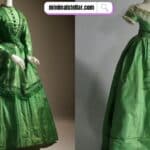Visual Kei is not just a musical genre, it is a dynamic cultural movement that has captivated audiences worldwide. Known for its dramatic fusion of fashion, music, and performance, this Japanese-born phenomenon embraces individuality and challenges traditional norms.
From its origins in the late 1980s, Visual Kei has left an indelible mark on the music and fashion industries. In this article, we will explore origins of Visual Kei, various sub-genres, and its impact on global fashion and culture.
The Origins of Visual Kei Style
Visual Kei emerged in the late 1980s in Japan, especially within the vibrant streets of Harajuku, Tokyo’s renowned fashion district. It was born out of a youth-driven desire for artistic freedom, rebellion, and self-expression. Influenced by Western glam rock, the movement adopted elements from these genres and infused them with traditional Japanese aesthetics.
The term “Visual Kei,” which translates to “visual style,” reflects the central role of appearance in this movement. It wasn’t just about music—it was a total sensory experience, where fashion were as important as the sound itself. The musical performances of Visual Kei artists were theatrical and often larger-than-life, with extravagant costumes, dramatic hair, and bold makeup. This emphasis on visual impact set the stage for a movement that would evolve into a global cultural force.
All You Need To Know About Harajuku Fashion Style
Fashion With Many Aesthetic Influences
Visual Kei fashion is a striking blend of multiple influences, drawing from Western rock culture. The result is a unique, hybrid style that defies easy classification, blending different cultural elements.
One of the most notable influences on Visual Kei fashion is glam rock, especially the work of artists. Their extravagant use of makeup, bold colors, and outlandish costumes became key elements in Visual Kei fashion. The androgynous look, flamboyant style, and theatrical performances of glam rock icons resonated deeply with the Visual Kei movement.
In addition to glam rock, punk fashion also played a significant role in shaping the Visual Kei aesthetic. The punk movement’s anti-establishment ethos and its distinctive clothing—such as leather jackets, studded accessories, and torn clothing. The punk influence is particularly visible in the more aggressive and avant-garde subgenres of Visual Kei.
Gothic Aesthetics and Traditional Japanese Elements
Gothic fashion, with its dark and dramatic themes, also helped shape Visual Kei’s look. The incorporation of gothic elements such as heavy makeup, dark clothing, and a somber atmosphere became integral parts of the Visual Kei identity.
Equally important are the traditional Japanese motifs found within Visual Kei. Bands and performers often incorporate elements like kimono-inspired designs, Noh masks, and other symbols from Japan’s rich cultural history. This mix of Western and Japanese aesthetics is what makes Visual Kei so distinctive, as it continuously bridges two cultural worlds while maintaining a unique identity.
Key Elements of the Visual Kei Fashion

Visual Kei fashion is unmistakable, thanks to its bold, boundary-pushing elements. The key features of this style create an eye-catching, theatrical look that allows performers to express their individuality and artistic vision.
Bold Makeup
Makeup is one of the most defining features of Visual Kei. It serves not just as an aesthetic tool, but as an integral part of the performer’s persona. From stark white face makeup to dark eyeliner and vivid lipstick, the makeup often enhances the emotional intensity of the performance, making the visual aspect of the movement just as important as the music itself. The makeup choices can range from dramatic and theatrical to dark and gothic, but they always reflect the artist’s unique identity.
Iconic Hairstyles
Hair plays an essential role in Visual Kei’s dramatic look. Tall, voluminous hairstyles are a staple, with performers often sporting wild, gravity-defying hair dyed in contrasting colors. These eye-catching hairstyles contribute to the overall intensity of the look, helping the performer stand out both on stage and in everyday life. The hairstyles can vary from spiked, mohawk-inspired looks to long, flowing, and meticulously styled hair.
Androgynous Fashion
One of the most striking aspects of Visual Kei is its defiance of gender norms. Men in Visual Kei often wear skirts, corsets, and other traditionally feminine clothing, challenging conventional ideas of masculinity and femininity. This fluidity in fashion allows for greater freedom of expression, as performers embrace clothing that resonates with their artistic vision, rather than adhering to societal expectations.
Exaggerated Accessories
Accessories are a critical element in Visual Kei fashion. From studded leather belts and choker necklaces to oversized rings and dramatic gloves, every detail is carefully chosen to enhance the overall look. These accessories often add to the boldness of the performance, contributing to the striking visual impact that is a hallmark of the genre.
Traditional Japanese Motifs
Despite its strong Western influences, Visual Kei remains deeply connected to Japanese culture. Many performers incorporate traditional elements, such as kimono patterns, samurai-inspired accessories, and Noh mask designs, into their outfits. This fusion of old and new helps to create a distinctive look that reflects Japan’s unique blend of ancient traditions and modern creativity.
Are Jeans Business Casual?
The Different Sub-Genres to Know
Visual Kei is a dynamic and ever-evolving movement, with various sub-genres that each offer a unique take on the overall aesthetic. These sub-genres vary in their musical and visual styles, but all maintain the core principles of individuality and artistic expression.
Oshare Kei
Oshare Kei is the more colorful and playful sub-genre of Visual Kei. With its emphasis on bright hues, and whimsical accessories, Oshare Kei is often seen as lighthearted counterpart to dark styles. This sub-genre can incorporate elements of kawaii (cute) culture, creating a playful fusion of fashion and self-expression.
Eroguro Kei
Eroguro Kei is a provocative and theatrical sub-genre that combines erotic and grotesque elements. Inspired by macabre art and literature, this sub-genre incorporates themes of death, decay, and sexuality into its fashion and performances. The look is dark, disturbing, and often surreal, challenging the viewer’s comfort zone and pushing boundaries.
Angura Kei
Angura Kei, also known as “underground” or “avant-garde” Visual Kei, emphasizes traditional Japanese aesthetics. This sub-genre draws heavily from Japan’s folklore and ancient rituals, creating a distinctly cultural take on the Visual Kei movement. Angura Kei is often characterized by its more subdued, artistic sensibility, blending old and new.
Kote Kei
Kote Kei is a nostalgic sub-genre that takes inspiration from the early days of Visual Kei, particularly the glam rock era of the 1980s. It features heavy use of leather, chains, and dark, gothic makeup, drawing heavily from the rebellious punk and glam rock influences that first shaped the Visual Kei movement.
Tambi Kei
Tambi Kei is a newer sub-genre that merges modern, Western aesthetics with traditional Visual Kei elements. The result is a fusion of contemporary fashion and timeless Visual Kei style, often featuring androgynous silhouettes and contemporary motifs that still retain the essence of Visual Kei’s boundary-pushing aesthetic.
Iconic Visual Kei Bands

Several bands have been instrumental in defining and popularizing Visual Kei, both in Japan and internationally. These bands helped shape the sound, style, and cultural significance of the movement, each contributing its unique flavor to the genre.
X Japan
Widely considered the founders of Visual Kei, X Japan fused rock, heavy metal, and classical music to create a sound that resonated with a wide audience. Their theatrical performances and bold fashion choices made them the quintessential Visual Kei band, and their influence continues to be felt today.
Dir En Grey
Known for their dark, intense music and visually striking performances, Dir En Grey has been one of the most influential bands in the Visual Kei scene. Their music ranges from heavy metal to softer ballads, and their ability to evolve stylistically has earned them a devoted international following.
Malice Mizer
Malice Mizer was known for their baroque-inspired visuals and theatrical performances. Their unique blend of gothic and classical music, combined with their elaborate costumes and stage presence, helped define a distinct sub-genre of Visual Kei that continues to inspire musicians today.
the GazettE
With their ability to blend contemporary elements with traditional Visual Kei aesthetics, the GazettE has managed to stay relevant and innovative throughout their career. Their fusion of heavy metal, punk, and gothic influences continues to make them one of the most influential bands in the scene.
Exploring the Caitlyn Minimalist Aesthetic
Versailles
Known for their opulent “rococo” aesthetic and symphonic metal sound, Versailles combines dramatic visuals with complex musical arrangements. Their fusion of classical music and metal, paired with their elaborate costumes, has made them a standout band within the Visual Kei movement.
Influence and Fans Around the World
Though rooted in Japan, Visual Kei has become a global cultural phenomenon. Its dramatic aesthetic, fluid approach to gender, and rebellion against social norms resonate with fans worldwide. Social media, the internet, and international music festivals have played a crucial role in spreading the influence of Visual Kei, allowing it to reach audiences far beyond Japan’s borders.
As the movement continues to evolve, Visual Kei has inspired countless artists in both music and fashion. Its influence can be seen in modern pop culture, with musicians, designers, and artists borrowing elements from the style. Visual Kei’s ability to blend the old with the new, as well as its message of individuality, ensures that its legacy will continue for years to come.
Conclusion
Visual Kei has grown from a niche cultural movement in Japan into a global force that challenges conventional boundaries of fashion, music, and identity. With its bold fusion of Western influences and traditional Japanese aesthetics, the movement has created a lasting impact on both the music and fashion industries. From its early beginnings with iconic bands like X Japan and Malice Mizer to the emergence of new sub-genres and contemporary bands, Visual Kei has proven to be a genre that continually evolves while staying true to its rebellious roots.
As the movement spreads further across the globe, Visual Kei continues to captivate fans and inspire new generations of musicians, designers, and artists. Its influence on fashion, music, and performance art cannot be understated, and it remains a powerful testament to the enduring appeal of individuality and artistic expression.
Frequently Asked Questions (FAQs)
What is Visual Kei?
Visual Kei is a Japanese music and fashion movement that emerged in the late 1980s. It combines theatrical music with bold, boundary-pushing fashion that blends elements of glam rock, punk, gothic, and traditional Japanese aesthetics.
What are the main characteristics of Visual Kei fashion?
Visual Kei fashion is known for its dramatic makeup, extravagant hairstyles, and androgynous clothing. It also incorporates gothic elements, traditional Japanese motifs, and exaggerated accessories to create a visually striking look.
Who are some of the most famous Visual Kei bands?
Some of the most famous Visual Kei bands include X Japan, Dir En Grey, Malice Mizer, the GazettE, and Versailles. Each band has contributed to the evolution and global popularity of the Visual Kei movement.
How has Visual Kei influenced global fashion and culture?
Visual Kei has influenced global fashion by promoting individuality, challenging traditional gender norms, and inspiring designers and artists around the world. It has also inspired international musicians and gained a dedicated global fanbase.
What are the sub-genres of Visual Kei?
Visual Kei has several sub-genres, including Oshare Kei (colorful and playful), Eroguro Kei (erotic and grotesque), Angura Kei (traditional Japanese influence), Kote Kei (nostalgic glam rock), and Tambi Kei (modern fusion of styles). Each sub-genre has its own distinct style and musical influence.

Eliana Amelia is the insightful author behind Minimal Stellar. With extensive experience in blogging, she expertly crafts content on the latest hair trends and cutting techniques. Eliana’s passion for haircare and style, combined with her professional expertise, ensures that her readers receive valuable, up-to-date advice. Her dedication to helping others look and feel their best shines through in every post.







